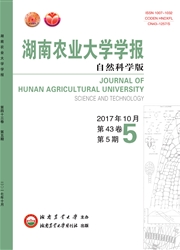

 中文摘要:
中文摘要:
利用微卫星(SSR)标记技术对分别来自四川和重庆的各15个玉米地方品种群体进行了遗传多样性分析.42对SSR引物在供试玉米品种中分别检测到多态性位点数256和248个,其位点数平均分别为6.1和5.9个,平均多态信息量分别为0.76和0.73.根据遗传相似系数矩阵作出的树状图,分别将四川和重庆的品种群体划分成4类和3类,四川品种群体间的遗传相似系数低于重庆,表明了前者较高的遗传分化程度.群体内遗传多样性和遗传结构分析结果表明,四川玉米地方品种的遗传多样性高于重庆;四川和重庆玉米地方品种群体的遗传结构均偏离了Hardy-Weinberg平衡;品种群体的遗传变异均以群体内遗传变异为主.SSR分子标记的遗传多样性分析不仅揭示出四川和重庆玉米地方品种丰富的遗传多样性,而且对其保护和利用提供了重要理论依据.
 英文摘要:
英文摘要:
The genetic diversity in landraces of 30 maize 15 from Sichuan and 15 from Chongqing, was tested by using 42 microsatellite (SSR) loci. 256 and 248 polymorphic alleles were detected, and the average number of alleles were 6.1 and 5.9, respectively, and the average polymorphism information content (PIC) were 0.76 and 0.73, respectively. Clustering analysis separated the landraces from Sichuan and Chongqing into 4 and 3 groups, respecively. In addition, the genetic diversity was greater in Sichuan than that in Chongqing. The results based on the gentic diversity and the genetic structure showed that there was an obvious genetic differentiation from Hardy-Weinberg expectation in the landraces from both Sichuan and Chongqing and a considerable genetic variation was revealed within rather than among landraces. The genetic diversity on the basis of SSRs provides a guide for maize breeders to conserve and utilize the germplasm.
 同期刊论文项目
同期刊论文项目
 同项目期刊论文
同项目期刊论文
 期刊信息
期刊信息
